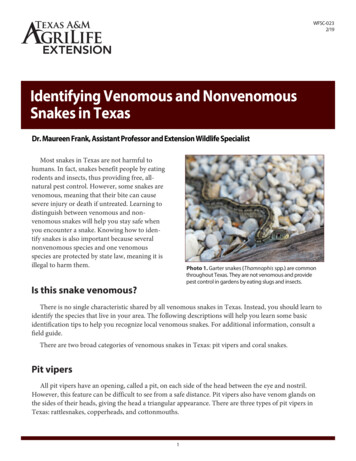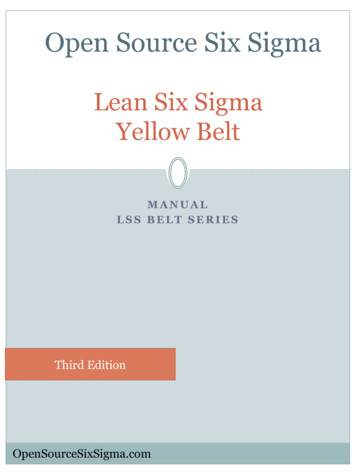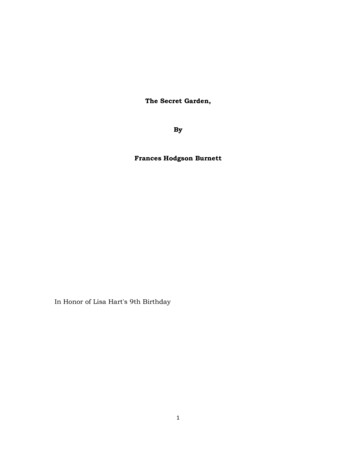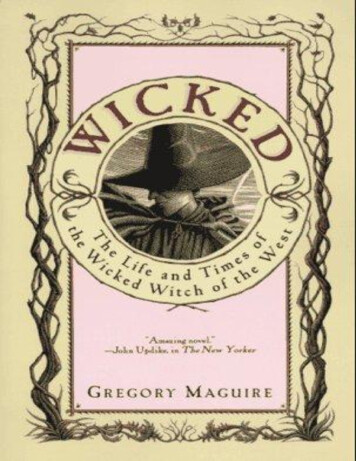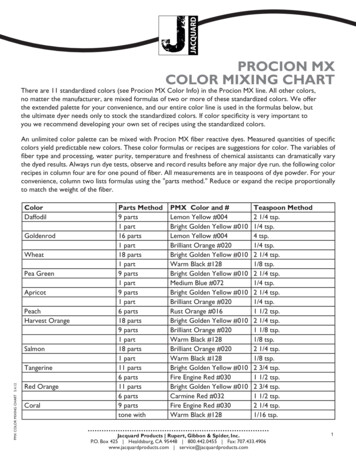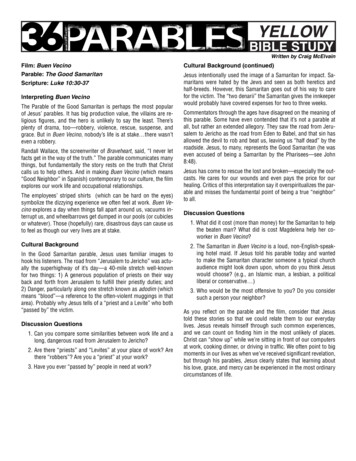
Transcription
YELLOWBIBLE STUDYWritten by Craig McElvainFilm: Buen VecinoParable: The Good SamaritanScripture: Luke 10:30-37Interpreting Buen VecinoThe Parable of the Good Samaritan is perhaps the most popularof Jesus’ parables. It has big production value, the villains are religious figures, and the hero is unlikely to say the least. There’splenty of drama, too—robbery, violence, rescue, suspense, andgrace. But in Buen Vecino, nobody’s life is at stake there wasn’teven a robbery.Randall Wallace, the screenwriter of Braveheart, said, “I never letfacts get in the way of the truth.” The parable communicates manythings, but fundamentally the story rests on the truth that Christcalls us to help others. And in making Buen Vecino (which means“Good Neighbor” in Spanish) contemporary to our culture, the filmexplores our work life and occupational relationships.The employees’ striped shirts (which can be hard on the eyes)symbolize the dizzying experience we often feel at work. Buen Vecino explores a day when things fall apart around us, vacuums interrupt us, and wheelbarrows get dumped in our pools (or cubiclesor whatever). Those (hopefully) rare, disastrous days can cause usto feel as though our very lives are at stake.Cultural BackgroundIn the Good Samaritan parable, Jesus uses familiar images tohook his listeners. The road from “Jerusalem to Jericho” was actually the superhighway of it’s day—a 40-mile stretch well-knownfor two things: 1) A generous population of priests on their wayback and forth from Jerusalem to fulfill their priestly duties; and2) Danger, particularly along one stretch known as adodim (whichmeans “blood”—a reference to the often-violent muggings in thatarea). Probably why Jesus tells of a “priest and a Levite” who both“passed by” the victim.Discussion Questions1. Can you compare some similarities between work life and along, dangerous road from Jerusalem to Jericho?2. Are there “priests” and “Levites” at your place of work? Arethere “robbers”? Are you a “priest” at your work?3. Have you ever “passed by” people in need at work?Cultural Background (continued)Jesus intentionally used the image of a Samaritan for impact. Samaritans were hated by the Jews and seen as both heretics andhalf-breeds. However, this Samaritan goes out of his way to carefor the victim. The “two denarii” the Samaritan gives the innkeeperwould probably have covered expenses for two to three weeks.Commentators through the ages have disagreed on the meaning ofthis parable. Some have even contended that it’s not a parable atall, but rather an extended allegory. They saw the road from Jerusalem to Jericho as the road from Eden to Babel, and that sin hasallowed the devil to rob and beat us, leaving us “half dead” by theroadside. Jesus, to many, represents the Good Samaritan (he waseven accused of being a Samaritan by the Pharisees—see John8:48).Jesus has come to rescue the lost and broken—especially the outcasts. He cares for our wounds and even pays the price for ourhealing. Critics of this interpretation say it overspiritualizes the parable and misses the fundamental point of being a true “neighbor”to all.Discussion Questions1. What did it cost (more than money) for the Samaritan to helpthe beaten man? What did is cost Magdelena help her coworker in Buen Vecino?2. The Samaritan in Buen Vecino is a loud, non-English-speaking hotel maid. If Jesus told his parable today and wantedto make the Samaritan character someone a typical churchaudience might look down upon, whom do you think Jesuswould choose? (e.g., an Islamic man, a lesbian, a politicalliberal or conservative )3. Who would be the most offensive to you? Do you considersuch a person your neighbor?As you reflect on the parable and the film, consider that Jesustold these stories so that we could relate them to our everydaylives. Jesus reveals himself through such common experiences,and we can count on finding him in the most unlikely of places.Christ can “show up” while we’re sitting in front of our computersat work, cooking dinner, or driving in traffic. We often point to bigmoments in our lives as when we’ve received significant revelation,but through his parables, Jesus clearly states that learning abouthis love, grace, and mercy can be experienced in the most ordinarycircumstances of life.
YELLOWBIBLE STUDYWritten by Craig McElvainFilm: Buried TalentParable: The TalentsScripture: Matthew 25:14-30Cultural Background (continued)Interpreting Buried TalentDoubling one’s investment was normal, and the servants should’vebeen able to accomplish this. The principle that integrity in smallermatters qualified one to prove one’s integrity in larger matters wasoften invoked in antiquity.The Parable of the Talents involves money, as a “talent” is anothername for currency. However, Buried Talent involves painting. So why isn’t this film about modern-day investments? As you watchthe film and explore the texts, consider that the deeper meaningof the parable examines stewardship beyond finance. God leavesmany things in our care: Money, friendships, charity, talents, etc.The title (Buried Talent) is an obvious play on words.The parable also involves fear and how fear can inhibit and freezeus. As you watch the film, consider the challenge the artists are given. It’s an extraordinary opportunity with tremendous resources but also limited time and instruction.Cultural BackgroundWealthy landowners usually delegated control and multiplicationof their wealth to trained accountants, or as this parable, servants.These landowners also often embarked on long journeys.Given the time period, the value of a talent was about 10,000 denarii. One denarius was a day’s wage. If you do the math, one talent was therefore worth a life’s wages for an average worker! Fivetalents were worth what each of these servants would make in fivelifetimes.Discussion Questions1. How can we compare the two propositions? (Investing coinsin the original parable and creating art in Buried Talent.)2. What are some things in your life that have been entrustedto your care?3. Do you sometimes feel that God asks much of you, but yousense a heavy burden to work it out on your own?One of the safest and least-profitable ways of protecting one’smoney was to bury it in the ground; such buried reserves are stilloccasionally found to this day.The third servant was afraid to do anything with his master’s assetsother than keep them “safely” below ground. He should’ve knownbetter; the smallest possible investment—providing interest on asavings deposit—wouldn’t have endangered the money, either.Discussion Questions1. Tom’s character is the most professional of the group. He hasa portfolio of work and is quite organized. Given this opportunity to be free to paint whatever he likes, he freezes and fails.Can you think of a time when you froze in the face of a similaropportunity and ended up “burying” your talent? What didyou learn from that situation?2. Jamie’s character is right out of college, and this is her firstinterview for a painting job. She’s the most nervous of thegroup, and yet she produces a marvelous painting. Can youthink of a time when you let your talent rise to the surfaceand experienced success? What did you learn from that situation?As you reflect on the parable and the film, consider that Jesustold these stories so that we could relate them to our everydaylives. Jesus reveals himself through such common experiences,and we can count on finding him in the most unlikely of places.Christ can “show up” while we’re sitting in front of our computersat work, cooking dinner, or driving in traffic. We often point to bigmoments in our lives as when we’ve received significant revelation,but through his parables, Jesus clearly states that learning abouthis love, grace, and mercy can be experienced in the most ordinarycircumstances of life.
YELLOWBIBLE STUDYWritten by Craig McElvainFilm: FoundParable: The Lost CoinScripture: Luke 15:8-10Cultural Background of the ParableMiddle-eastern history tells us that the lost coin may have beenfrom this woman’s wedding headdress (the equivalent of a modern-day wedding ring). In the first century, this coin may well havebeen part of a woman’s dowry (the asset she brought into themarriage)—an asset of great sentimental and intrinsic value. Thesilver coins in her possession would likely be the only money shebrings into the marriage—it’s money that remains hers even if themarriage is dissolved. The fact that she has only 10 coins (worthabout 10 days of a worker’s wages) suggests that her father’s family is not well off financially—which presumes that, if a weddingis coming, she’d be marrying into a household of equally limitedmeans.Intrinsic vs. Extrinsic ValueSome things have very low extrinsic value—such as the necklacein the video parable. It might have a street value of, say, 100 at themost. But when you factor in the intrinsic value of the item—whatit represents to its owner—its value is far greater.Discussion Questions1. How does the necklace in Found compare to the man’s otherpossessions?2. If your home became engulfed in flames, and you could rescue ONE item only—the single possession that means themost to you—what item would you save?3. If this one item were valued on e-Bay, what price do you suppose would secure the winning bid?4. What price would you accept for it?5. How does God value “lost people”? Why do they matter toGod? What is their “intrinsic” value?Cultural Background (continued)Floors in the ancient Middle East were often woven and thereforehad a lot of cracks—many, many places where a dropped itemcould hide itself indefinitely. That, plus the lack of windows and badlighting, made it nearly impossible to find something that slippedthrough the cracks. To locate a lost item, one had to practically turnthe house upside-down.Discussion Questions1. What kinds of losses have you experienced?2. Where were you when Jesus found you? What crack had youfallen into?3. We often identify people who don’t have a relationship withJesus but begin going to church as “seekers”—but in thisparable, God does the seeking. If we understood God’s heartfor people who are lost, what people can you think of whoyou’d pursue that you aren’t currently pursuing?As you reflect on the parable and the film, consider that Jesustold these stories so that we could relate them to our everydaylives. Jesus reveals himself through such common experiences,and we can count on finding him in the most unlikely of places.Christ can “show up” while we’re sitting in front of our computersat work, cooking dinner, or driving in traffic. We often point to bigmoments in our lives as when we’ve received significant revelation,but through his parables, Jesus clearly states that learning abouthis love, grace, and mercy can be experienced in the most ordinarycircumstances of life.
BLUEBIBLE STUDYWritten by Craig McElvainFilm: The Music BoxParable: The Hidden TreasureScripture: Matthew 13:44Interpreting The Music BoxA man is out buying antique music boxes and “stumbles upon” abox of superior value. The box played a crucial role in his childhoodand has great sentimental value to him. The result is that the manwill pay whatever it takes to get that box—however many zeroshe must add to his check. The owners wonder if they’ve missedsomething, but they finally agree to sell. The man is ecstatic sincethe box is far more important to him than the money.To “stumble upon something” is to find it through no effort of ourown. It’s an accident.in reality, that “something” finds us. Jesussays this is very similar to the Kingdom of God. It finds us. We don’tfind it. This is the image Jesus paints in the parable of the HiddenTreasure. A first-century farmer might’ve had his own anecdotalversion of this story—a moment in the past when a friend literally“stumbled upon” a hidden treasure. This was somewhat common,since banks were unusual in Palestine. Farmers would often hidetheir treasures in their fields at secret locations. This worked well—except in cases of accidental or sudden deaths. If the farmer diedunexpectedly, the secret hiding place went to the grave with him.Then maybe 50 years later some sharecropper would run his plowinto an obstacle, only to find it’s buried treasure he stumbled upon.If the sharecropper didn’t own the field, he’d sell everything he hadto purchase it, knowing full well that the value at the end of the daywould far exceed the purchase price.Read the Following Passages TogetherMatthew 10:37-39Matthew 6:19-21Mark 8:34-36Luke 12:13-21Discussion Questions1. Have you ever “stumbled upon” a great “treasure”?2. Why do we tend to hang onto our stuff instead of exchangingit for the Kingdom of God?3. If you’ve already sold out to the Kingdom, what benefits wouldyou say have outweighed the costs?4. What do you find yourself hanging on to (still) in the midst ofthis spiritual transaction?5. Do you see yourself as having “stumbled upon” the kingdom,or are you more prone to see it as something you’ve searchedfor, found, and earned?As you reflect on the parable and the film, consider that Jesustold these stories so that we could relate them to our everydaylives. Jesus reveals himself through such common experiences,and we can count on finding him in the most unlikely of places.Christ can “show up” while we’re sitting in front of our computersat work, cooking dinner, or driving in traffic. We often point to bigmoments in our lives as when we’ve received significant revelation,but through his parables, Jesus clearly states that learning abouthis love, grace, and mercy can be experienced in the most ordinarycircumstances of life.
BLUEBIBLE STUDYWritten by Craig McElvainFilm: Gnobody’s GnomeParable: The Parable of the Unmerciful ServantScripture: Matthew 18:15-35Interpreting Gnobody’s GnomeWe all want to be treated mercifully but we tend to dole out rawjustice to others in need of mercy. That’s the simple plot of thisfilm. The middle-aged yuppie Harold is in deep water financially.He’s hoping the judge will see his situation in a merciful light, particularly if he liquidates his prized gnome collection. One problem:He’s loaned “Sneezy” to his neighbor. Strangely enough he can’tsee his neighbor’s need in the same light of mercy that he sees hisown plight, so he demands justice. He wrenches the gnome fromhis befuddled neighbor’s hands. In the film’s conclusion, the judgedecides to give Harold exactly what he’s given his neighbor—rawjustice.Cultural BackgroundJesus launched into this parable in response to Peter’s questionabout forgiveness. Rabbis were known to say that forgiveness is tobe extended three times before finally refusing to indulge a habitualsinner. Peter believed he was being wildly magnanimous when hesuggested to Jesus that people ought to be forgiven up to seventimes. But Jesus instead says “seventy times seven.” This Hebrewidiom was used as an equivalent to our concept of infinity—i.e.,more times than you can count.Jesus then followed up his shocking proclamation with a parablethat might have been common in the first century. A king calls inhis servants and asks them to settle accounts. One particular steward owes the king the equivalent of several million dollars (10,000talents was equal to 375 tons of silver—more than Herod theGreat’s annual revenue). The obvious question is how this steward could’ve ever acquired so large a debt. On his civil servant’ssalary, his request of the king to “be patient, and I will pay it all”was beyond ludicrous. The king decides, in light of this impossiblesituation, to shock the man and tear up the entire stack of IOUs.One might think this would set off the celebration of the century forthis lucky steward, but instead he plows headlong into an unthinkable hypocrisy. He meets a man who owes him “100 denarii” (theequivalent of the cost of an iPod; much easier to pay off than thedebt the servant owed the king). But instead of frolicking in themercy he’d just received, he decides to dole out raw justice andthrows this man into prison.The king’s other servants saw this hypocrisy play out, so they return to their master and relate the whole affair to him. Enraged, hesends them back to capture the unmerciful servant and have himturned over to the jailers for “torture” until he paid back all he owes.With some of his harshest words, Jesus says to the crowd listening: This is how my heavenly Father will treat each of you unlessyou forgive your brother from your heart.Discussion Questions1. Why is it so easy for us to dole out raw justice to people inneed?2. What about our lack of forgiveness boggles God’s mind?3. How big is your pile of IOUs before God in comparison to thepile you hold from other people?4. Won’t being merciful to others who repeat the same sins overand over simply indulge them, giving them no reason to repent?ApplicationForgiveness can only occur when I realize the phenomenal debt thatGod has forgiven me. The root of mercilessness is found in a lackof honest self-awareness. I once had a roommate who borrowedmy car for just about everything. During his junior year of collegehe finally got his own car. One time when my car had broken down Iasked to borrow his car so I could take a test on campus. He lookedme straight in the eye and said, “It’s my policy not to loan my carto anyone.” I was blown away. The hypocrisy of the whole thingenraged me. I now see that this is how God must feel when I refuseto tear up other people’s IOUs. In light of the enormous pile Godhas torn up for me, no debt is too great for me to forgive.Discussion Questions1. What debts are most difficult for you to forgive:a. The little irritations?b. The slaps to your ego?c. The ones that happen over and over?d. The big deals?2. If you could see your sin from God’s perspective, wherewould you see a pattern of repetition (doing the same wrongover and over)?3. What could help you get in touch with the depth of your IOUsto God?4. If you realize you’ve held on to someone’s IOU, what shouldyou do to make it right?As you reflect on the parable and the film, consider that Jesustold these stories so that we could relate them to our everydaylives. Jesus reveals himself through such common experiences,and we can count on finding him in the most unlikely of places.Christ can “show up” while we’re sitting in front of our computersat work, cooking dinner, or driving in traffic. We often point to bigmoments in our lives as when we’ve received significant revelation,but through his parables, Jesus clearly states that learning abouthis love, grace, and mercy can be experienced in the most ordinarycircumstances of life.
BLUEBIBLE STUDYWritten by Craig McElvainFilm: Like Father Like SonParable: The Two DebtorsScripture: Luke 7:36-48Interpreting Like Father Like SonWe all have the tendency to view our sins as indicative of run-ofthe-mill brokenness—and the sins of others as somehow dastardlyand insidious. That’s our fallen human nature. In this video the pastor (the father) cannot see the similarities between his issues andhis son’s issues. He’s blind to his own condition. Then enter thegrandfather. Although he lacks physical sight, he can see clearlythe parallels between his son and grandson. He sees that both arein need of forgiveness.Cultural BackgroundJesus tells a short parable about our inability to see clearly in Luke7. It’s in response to the arrogance of a religious leader named Simon who has invited Jesus to a meal at his home (probably a postsynagogue pot-luck). The culinary customs of the day required thatthey recline at a table, propped up by one arm, with their legs pointing away from the table, using the other arm to eat. This would’veleft Jesus’ feet exposed to those serving.Into this scene slipped an uninvited woman whose immoralitywas notorious. She may have been a prostitute, or maybe just awell-known party girl. We don’t really know what her particular sinwas—except for the clear implication that her reputation precededher. Overcome with sobbing, she kneels at Jesus’ feet and showersthem with fluids—i.e., her own tears and even some very expensiveperfume. Some have speculated that this perfume was a tool of thetrade for prostitutes, while others suggest she bought this expensive ointment with the proceeds from her questionable activities.Either way—hers was a clearly shocking act. And then, to makematters worse, she kissed Jesus’ feet while trying to wipe awayher tears with her unfurled hair. This was a no-no in first-centuryIsrael. A reputable woman never unfurled her hair in public—whichshows how blind this woman had become to others’ opinions. Theonly opinion she cared about was Jesus’.Simon, on the other hand, had neglected all the normal middleeastern etiquette. He failed to provide water to wash the guest’sfeet, to anoint the guest’s head with oil, and he even failed to greethis guest with a kiss—such neglect was the equivalent of refusingto even shake hands. It’s this contrast between Simon and the sinful woman that sends Jesus into storytelling mode.Discussion Questions1. When have you perceived other people wrongly, or have beenwrongly perceived by others?2. In our culture, what sins are socially “acceptable”? What sinsare culturally “notorious”?3. What actions would classify someone as a “sinful” persontoday?4. How accurately do you think you see your own sinfulness?ApplicationJesus told a parable about two debtors—one who owes 500 denarii,and one who owes 50 denarii. (One denarius was a day’s wage.) Inboth cases the debtors are incapable of paying. That’s when thetwist turns the story. The moneylender forgives both debts! ThenJesus grilled Simon with a few well-placed questions:Which of the debtors will love the moneylender the most? Simonrightly replied that the one with the bigger debt will love more.Which brought Jesus to question number two:“Do you see this woman?”This is the crux of Jesus’ story. Sometimes we only see what wewant to see. We’re blind to the obvious. Simon looked at this woman and could only see her sinful reputation; Jesus wanted Simon tosee his own sinfulness (which God can forgive) and the woman’sforgiven status. Jesus wanted Simon to see the distance betweenhis own sin and the woman’s sin as truly non-existent.Jesus wanted Simon to know that his “smaller” debt was nothing toboast about—he and the woman were both sinners in God’s eyes.How often do we share Simon’s arrogance that blinds us to thetruth about ourselves and others? It’s very likely the reason why somany of us are lukewarm in our affection and devotion to Jesus; wesimply don’t see clearly the size of the debt he’s forgiven us—andour inability to pay it.Discussion Questions1. Do you see your debt asBigger than other people’s?Smaller than other’s?About the same as other’s?2. What makes you blind to your own brokenness?3. How passionate are you in your devotion to Jesus? Whatcould you do to increase that passion?4. Do you think the habit of confessing specific sins would create in you more gratitude, or more guilt?5. What sins are acceptable in the church today?6. How can the church keep from ignoring some sins while inflating othersAs you reflect on the parable and the film, consider that Jesustold these stories so that we could relate them to our everydaylives. Jesus reveals himself through such common experiences,and we can count on finding him in the most unlikely of places.Christ can “show up” while we’re sitting in front of our computersat work, cooking dinner, or driving in traffic. We often point to bigmoments in our lives as when we’ve received significant revelation,but through his parables, Jesus clearly states that learning abouthis love, grace, and mercy can be experienced in the most ordinarycircumstances of life.
CYANBIBLE STUDYWritten by Craig McElvainFilm: Spilt MilkParable: New Wine in Old Wine SkinsScripture: Luke 5:36-392. Can you think of a time that the church has responded to a new idea with, “We’ve never done it that waybefore”—and then ended up doing things the sameold way?Interpreting Spilt Milk3. What way of knowing God do you hang onto because you like (or are most comfortable with) yourold cup?The child in this film understands that milk is poured intoa bowl filled with cereal. But he looks inside the fridgeand sees the gallon he usually pours into the cereal anddecides to use it—except that the gallon of milk is rotten. It’s past its prime and he pays a price for drinkingit. Overlooking the new nonfat milk, he figures, “I can stilluse the gallon container because that’s what I’m usedto.”Cultural BackgroundWine and wineskins were to people of the first centuryjust as convenience store paper cups and diet soda are tous. We all know you can refill an old paper cup with newsoda for less money than buying a new one filled withnew soda. The problem is, after a while a reused papercup gets nasty it leaks! So we throw it out and start allover again. The same was true for wine and wineskins.When you got a new batch of wine, it was no big deal tofill up your old wineskin with it—that is, until it sprung aleak (as old wineskins were prone to do). You don’t hangon to the old nasty thing and declare, “I don’t care if thewine spills or not—I’m keeping my vintage wineskin!”That would be foolishness. Yet that’s exactly what religious people have done, over and over again, throughoutchurch history. Jesus saw it happening in his own day asthe Pharisees tried to hold to the “synagogue” wineskinsof their day. Jesus wasn’t telling them that their traditions and structures were bad, but rather, like old papercups or worn-out wineskins, they no longer served theirpurpose: To carry the wine! The skin isn’t the issue—thewine is.Discussion Questions1. What wineskins do we hang onto in church today?Ways of doing things that no longer hold togethereffectively?4. What pioneers were once “new wineskins” but arenow old hat?ApplicationJesus did religion differently than the Jewish leaders wereused to. He “ate with sinners.” He taught on hillsides andfrom the bows of boats. He didn’t follow the “old wineskin” habits of hand washing and Sabbath-keeping. Asa result, the religious authorities despised Jesus. Theysaid, in essence, “We’ve never done it that way before,so you’re sinning.” In this simple parable Jesus at onceunnerved and reassured them. He wanted them to knowthat the old “traditions” were being tossed out like nastyold cups or leaky wineskins because they no longer didthe job of holding the new wine of the gospel. Any wineconnoisseur knows that wine is alive—it breathes, it expands. Jesus taught that God’s word is also alive andcannot be contained by any “once and for all” wineskin. Itcrosses cultures and ethnicities, and in each situation thewineskin looks different, but it’s still the same old (new)wine! The skin (its container) will change, but the wineremains the same. We struggle with this today. When wefind a way of doing church that works, we hang on fordear life sometimes years after it starts leaking. Wemust remember that any single wineskin cannot containthe gospel; it will always burst.Discussion Questions1. What things need to remain the same if the wine’sgoing to remain intact?2. How do we distinguish the wine from its wineskin?3. Where do you see leaks in our current way of operating?
CYANBIBLE STUDYWritten by Craig McElvainFilm: a few weeks laterParable: The Rich FoolScripture: Luke 12:16-21Interpreting a few weeks latera few weeks later takes place after the death of the Rich Fool,so it’s told somewhat in retrospect in relation to the parable.In this case, the wife is the “fool” since she acquired an immense amount of clothing that she never wore—then shedied, and her widower is left to pick up the pieces. This isn’ta stereotypical attack on women who own too many clothes;this is a story of a person who owns countless things she hasmerely stored up. The tags are still on the clothing. And hergrieving husband must “empty her barns,” so to speak, andprocess the parable vicariously.Cultural BackgroundThe context of Jesus’ parable is a dispute between two brothers. Jewish law said that the eldest brother received a doubleshare of the father’s inheritance, while the rest of the money was split between the remaining brothers. We don’t really know for sure, but it might be a case where a youngerbrother feels ripped off because of the inheritance division,so he’s hoping Jesus will publicly side with him. From Jesus’perspective, this guy is trying to make this a “fairness” issuewhen in reality it’s about greed—the desire for more stuff. Soin essence he says, “Quit acting like you don’t care about stuffwhen you do everything you can to acquire it”—i.e., “A man’slife does not consist in the abundance of his possessions” (v.15). This is where we get confused; we don’t know the meaning of the word enough. Most of us have more than enough,but often we believe it unfair that we don’t have more. Suchpretense is a bunker for our covetousness.Discussion Questions1. Where in life do you feel ripped off?2. What would change in your life if you stopped acquiringthings once you really had “enough” things?3. How do we know when we have enough?ApplicationThe Epicureans had a well-known philosophy in Jesus’ day—“eat, drink, and be merry.” For them the 20th-century bumpersticker gets it right: “He who dies with the most toys—wins.”Jesus’ parable about the Rich Fool is a cautionary tale for allof us who believe that consumption defines life. We western-ers typically deny they believe this, but our lifestyles contradict that. Americans are buried under a mountain of consumerdebt (more than 2 trillion in 2001). More than that, the average household carries a consumer debt of 12,000, and acredit card debt of 8,000. Plus 60 percent of us spend moreeach year than we have coming in! No wonder Jesus foundthat covetousness (the desire for more stuff) is something wemust be on “guard against.” We give lip service to the “youcan’
BIBLE STUDY Written by Craig McElvain YELLOW Cultural Background (continued) Jesus intentionally used the image of a Samaritan for impact. Sa-maritans were hated by the Jews and seen as both heretics and half-breeds. However, this Samaritan goes out of his way to care for the vi

